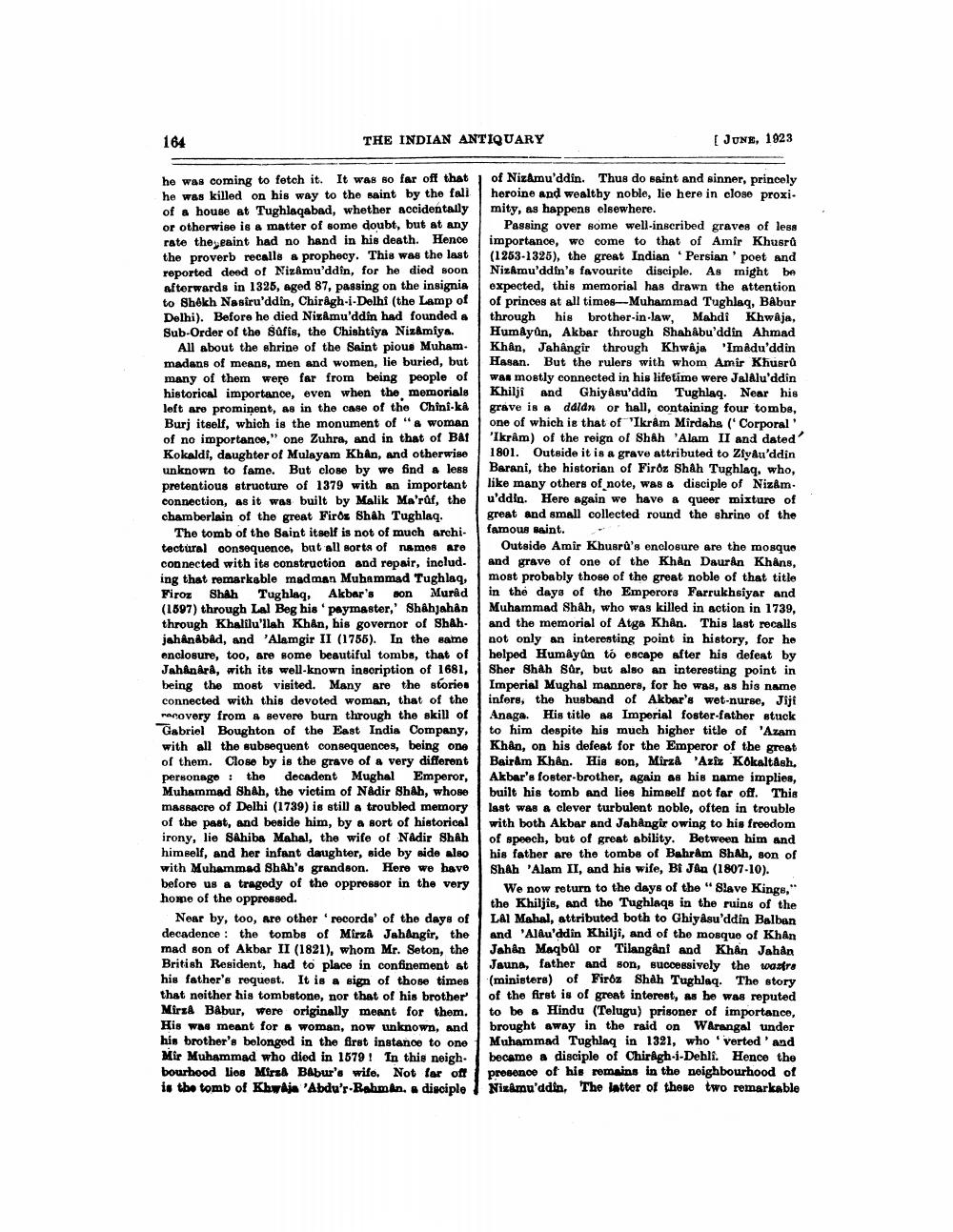________________
164
THE INDIAN ANTIQUARY
[ JUNE, 1923
he was coming to fetch it. It wa# so far off that of Nizamuddin. Thus do seint and sinner, princely he was killed on his way to the saint by the fall heroine and wealthy noble, lio here in close proxi. of a house at Tughlaqabad, whether accidentally mity, as happens elsewhere. or otherwise is a matter of some doubt, but at any Passing over some well-inscribed Brava rate the eaint had no hand in his death. Hence importance. Wo come to that of Amir Kh the proverb recalls a prophecy. This was the last (1263-1325), the great Indian Persian poet and reported deed of Nizamuddin, for he died soon Nizamu'ddin's favourite disciple. As might be afterwards in 1325, aged 87, passing on the insignia expected, this memorial has drawn the attention to Shokh Nasiru'ddin, Chiragh-i-Delhi (the Lamp of of princes at all times-Muhammad Tughlag, Babur Delhi). Before he died Nizâmu'ddin had founded a through his brother-in-law. Mahdi KhwAin. Sub-Order of the safis, the Chishtiya Nizamiya. Humayun, Akbar through Shahabu'ddin Ahmad
All about the shrine of the Saint pious Muham. Khan, Jahangir through Khwaja 'Imádu'ddin madans of means, men and women, lie buried, but Hasan. But the rulers with whom Amir Khuer many of them were far from being people of was mostly connected in his lifetime were JalAlu'ddin historical importance, even when the memorials Khilji And Ghiyâsu'ddin Tughlaq. Near his left are prominent, as in the case of the Chini-ke grave is a ddidn or hall, containing four tombe, Burj itself, which is the monument of "a woman one of which is that of 'Ikram Mirdahs ('Corporal of no importance," one Zuhra, and in that of Bar 'Ikrâm) of the reign of Shah 'Alam II and dated' Kokaldi, daughter of Mulayam Khan, and otherwise 1801. Outside it is a grave attributed to Zfyêu'ddin unknown to fame. But close by we find a less
Barani, the historian of Firoz Shah Tughlaq, who, pretentious structure of 1379 with an important like many others of note, W&S & disciple of Nizâm. connection, as it was built by Malik Ma'raf, the u'ddin. Here again we have a queer mixture of chamberlain of the great Firos Shah Tughlaq. great and small collected round the shrine of the
The tomb of the saint itself is not of much archi- famous saint. tectural consequence, but all sorts of namos are Outside Amir Khusru's enclosure are the mosque connected with its construction and repair, includ. and grave of one of the Khân DaurAn Khans, ing that remarkable madman Muhammad Tughlaq, most probably those of the great noble of that title Firoz Shah Tughlaq, Akbar's son Murad in the days of the Emperore Farrukhsiyar and (1597) through Lal Beg his paymaster,' Shahjahan Muhammad Shah, who was killed in action in 1739, through Khalilu'llah Khan, his governor of Shah. and the memorial of Atga Khân. This last recalls jahanabad, and 'Alamgir II (1755). In the same not only an interesting point in history, for he enclosure, too, are some beautiful tombs, that of helped Humayun to escape after his defeat by Jahanara, with its well-known inscription of 1681, Sher Shah Sur, but also an interesting point in being the most visited. Many are the stories Imperial Mughal manners, for he was, as his name connected with this devoted woman, that of the infers, the husband of Akbar's wet-nurse, Jiji recovery from a severe burn through the skill of Anaga. His title 48 Imperial foster-father stuck Gabriel Boughton of the East India Company, to him despite his much higher title of 'Azam with all the subsequent consequences, being one Khan, on his defeat for the Emperor of the great of them. Close by is the grave of a very different Bairam Khân. His son, Mirza 'Aziz Kokaltash. personage : the decadent Mughal Emperor, Akbar's foster-brother, again as his name implies, Muhammad Shah, the victim of Nadir ShAh, whose built his tomb and lies himself not far off. This massacre of Delhi (1739) is still a troubled memory last was a clever turbulent noble, often in trouble of the past, and beside him, by a sort of historical with both Akbar and Jahangir owing to his freedom irony, lie Sahiba Mahal, the wife of Nadir Shah of speech, but of great ability. Between him and himself, and her infant daughter, side by side also his father are the tombs of Bahram Shah, son of with Muhammad Shah's grandson. Here we have Shah Alam II, and his wife, Bi Jan (1807-10). before us a tragedy of the oppressor in the very
We now return to the days of the "Save Kings," home of the oppressed.
the Khiljis, and the Tughlaqs in the ruins of the Near by, too, are other records of the days of LAI Mahal, attributed both to Ghiyåsu'ddin Balban decadence: the tombs of Mirza Jahangir, the and 'Alau'ddin Khilji, and of the mosquo of Khân nad son of Akbar II (1821). whom Mr. Seton, the Jahan Maqbal or Tilangan And Khan Jahan British Resident, had to place in confinement at Jauna, father and son, successively the warra his father's request. It is a sign of those times (ministers) of Firoz Shah Tughlaq. The story that neither his tombstone, nor that of his brother of the first is of great interest, as be was reputed Mirza Babur, were originally meant for them. to be a Hindu (Telugu) prisoner of importance, His was meant for a woman, now unknown, and brought away in the raid on Warangal under his brother's belonged in the first instance to one Muhammad Tughlaq in 1321, who'verted' and Mir Muhammad who died in 1579! In this neigh. became a disciple of Chiragh-i-Dehlí. Hence the bourhood lies Mirsa Babur's wife, Not far oft presence of his remains in the neighbourhood of is the tomb of Khyrje 'Abdu'r-Rahman. & disciple 1 Nizamu'ddin, The latter of these two remarkable




